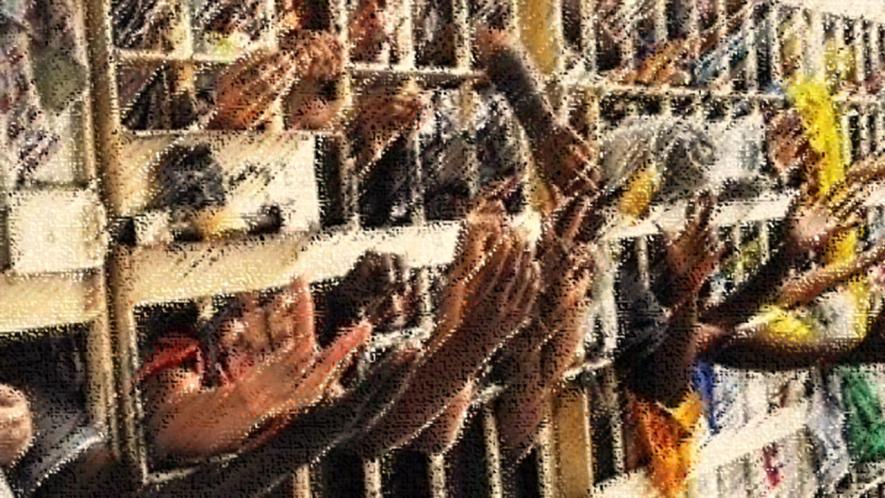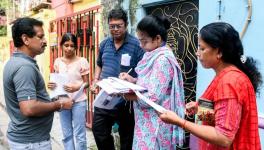No Headway in Decongestion of Maharashtra Prisons, Despite SC Directive

Representational image. | Image Courtesy: The Leaflet
Mumbai: On March 23, the Supreme Court of India asked the state governments to decongest prisons in order to prevent the spread of coronavirus inside jail premises. The Maharashtra government, led by Chief Minister Uddhav Thackeray, subsequently constituted a high-power committee (HPC) to decide on the prisoners to be released. However, the decongestion process in Maharashtra seems to be going nowhere.
As of May 31, Maharashtra’s 60 prisons had 28,920 inmates. According to the data on June 19, that number stands at 28,950. In other words, 30 prisoners have instead been added in the 20 days of June. The official capacity of all the prisons in the state is actually 24,030.
In Taloja Central Prison, located in Navi Mumbai, there were 2,186 inmates on May 31. On June 19, that number increased to 2,313. The original capacity of the prison is 2,134.
In the women's prison at Byculla, the number of inmates has decreased from 302 to 281 between May 31 and June 19. But it is still over the official capacity of 262.
During a pandemic, even if prisons are packed to their original capacity, it is said to be dangerous for the well-being of prisoners. In Maharashtra, the prisons are seriously overcrowded, and fertile ground for the spread of coronavirus.
Read Also: COVID-19: Things Getting Really Bad in Overcrowded Maharashtra Prisons
Taloja is the same prison where nine human rights activists, lawyers, and scholars have been jailed in connection with the controversial Bhima Koregaon case.
Anand Teltumbde, Surendra Gadling, Varavara Rao, Mahesh Raut, Arun Ferreira, Gautam Navlakha, Sudhir Dhawle, Rona Wilson and Vernon Gonzales have all been critical of the Narendra Modi-led Union government. They are lodged in the Taloja prison.
Sudha Bharadwaj and Shoma Sen are at Byculla prison.
The political activists are booked under the Unlawful Activities (Prevention) Act (UAPA), and are accused of plotting the assassination of Modi, while having links with banned Maoist outfits. Critics say the charges against them are politically motivated as they all have an exemplary reputation of speaking up for the deprived sections of the society.
But the HPC has excluded prisoners charged or convicted under the Special Acts from being eligible for temporary bail. Therefore, the activists jailed in the Bhima Koregaon case will not be able to avail the benefits of the HPC guidelines. But they can file regular bail applications.
Almost all of them are aged above 60, and have comorbidities, making them more vulnerable to coronavirus.
State Govt’s Affidavit on Coronavirus
In an affidavit submitted to the High Court on June 15, the Inspector General of prisons and correctional services, Maharashtra, Sunil Ramanand, revealed that two prisoners had died in Taloja. Both were tested for coronavirus after they died. And both tested positive.
In a virtual admission of the virus having penetrated the prison, Ramanand’s affidavit read: “Mass swab testing of asymptomatic prison inmates may not be undertaken until express assurance of quarantine facility is given by the Municipal Commissioners/Collectors as many of the prisons in the state are overcrowded.”
There were 29,762 prisoners in Maharashtra as of May 23, 2020. “In order to manage COVID-19, the prisons need to be decongested to 2/3rd of its official capacity (for effective creation of quarantine wards),” Ramanand’s affidavit read. “Hence the manageable prison population in the state of Maharashtra is 16,000. A decrease in the current prison population by almost 14000 is needed,” the state government’s affidavit, filed in response to the public interest litigation (PIL) filed by the People’s Union for Civil Liberties (PUCL) on the condition of prisons in Maharashtra, added.
To apply the same math for Taloja Prison, at two-thirds of the capacity, it should ideally have 1,416 inmates. To bring the inmates down to that number, the prison authorities would have to release 897 prisoners on bail and parole. From Byculla, they would have to release 106 inmates.
However, during an order on June 16, The High Court said there are only 1,364 pending bail applications across Maharashtra to “avail the benefits of the High Powered Committee's (HPC) recommendations”.
It is nowhere near enough to successfully decongest prisons to two-thirds of their capacity, which begs the question: What did the HPC achieve?
Decongestion of Prisons, a Far Cry
On May 12, a day after the HPC met, a decision to release 17,000 prisoners from Maharashtra’s jails was announced. But since the beginning of June, the prisoners have actually increased.
The decongestion of prisons transpires in two ways. The state government can release convicts on parole. And the courts can release undertrials on bail. The authorities seem to be slacking on both counts, for the prisoners have not gotten out, defeating the purpose behind the constitution of the HPC.
On June 19, Advocate General (AG) Ashutosh Kumbhakoni, representing the state government, submitted that the “Collectors of 27 districts throughout the State of Maharashtra have declared 36 locations as temporary prisons. In other revenue districts, steps are being taken to declare appropriate places accordingly, as temporary prisons. These premises are being used for decongesting the prisons. Such places declared as temporary prisons shall also be used as ‘Quarantine Centre’ and ‘Covid Care Centre’ by providing proper partitioning and required facilities.”
However, during the virtual hearing on June 26, the AG admitted that there was no additional staff being hired for the quarantine centres and temporary prisons, according to a source who attended the hearing.
“If the existing staff is rotating between temporary prisons and regular prisons, what is the point of the whole exercise of isolation?” asked the source. “The entire purpose of quarantine and avoiding intermixing of people is defeated. Jail staff is the one that comes in contact with everybody by going around. When a virus or a disease penetrates the prison, it usually goes through the staff.”
Exposing the farce of quarantine centres further, human rights activist Gautam Navlakha’s partner, Sahba Husain, in a letter to filmmaker Anand Patwardhan, said the quarantine centre for Taloja prison, a school building, was in “deplorable” condition.
“There are 35 inmates crowded into six classrooms in the building with Gautam having to share the room with 35 others,” she wrote to Patwardhan earlier this week. “There are only 3 toilets, 7 urinals and a common bathing space without a bucket or mug. He has lost 2 kg in three weeks of prolonged quarantine. Taloja does not seem to have space for new prisoners like him,” she added.
On June 25, when Rama Teltumbde spoke to her husband, author Anand Teltumbde, he informed her that Navlakha had been moved to the jail premises. Teltumbde could not speak in detail, because he wanted to speak to his ailing mother as well.
Human Rights of Prisoners
On June 21, PUCL submitted a list of recommendations in the High Court in order to protect the human rights of prisoners during the pandemic.
The note read: “In order to keep staff and incarcerated individuals safe, the state must immediately conduct mass testing of all staff and incarcerated people and take other extreme proactive measures for those most vulnerable to COVID – 19.”
In response to that, the AG, on June 26, said the state would start testing inmates and staff once the rapid antigen testing kits were available. However, he clarified that mass testing would not be possible. Only inmates with comorbidities would undergo the test.
In spite of that, the prisoners continue to be at risk. Experts say the peripheral solutions need to be accompanied by what lies at the core: decongestion.
The PUCL note goes on to say: “Between the decision of the 1st HPC (24.3.20) and 2nd HPC (11.5.2020), 5,105 undertrial prisoners were granted temporary bail and 2,229 convicts were granted emergency parole.”
On May 5, 2020, the note added, the prison population was 34,000. “This may be because many of the prisoners granted parole and temporary bail may not have been released then and some new arrestees may have been brought in,” the note said.
On June 19, the total prison population of 28,950 was still more than the average capacity of 24,000 and the desirable number of 16,000 for the pandemic. "Decongestion of prisons is the key response for the COVID outbreak in prison. However this has not happened,” the recommendation note concluded.
The writer is an independent journalist.
Get the latest reports & analysis with people's perspective on Protests, movements & deep analytical videos, discussions of the current affairs in your Telegram app. Subscribe to NewsClick's Telegram channel & get Real-Time updates on stories, as they get published on our website.
























